“Booming Business – Tiny Brightwood post office will soon be upgraded in status, and position of officer in charge will be changing to postmaster. Kay Hudon, who’s now officer in charge, is applying for the new job.”


“Booming Business – Tiny Brightwood post office will soon be upgraded in status, and position of officer in charge will be changing to postmaster. Kay Hudon, who’s now officer in charge, is applying for the new job.”
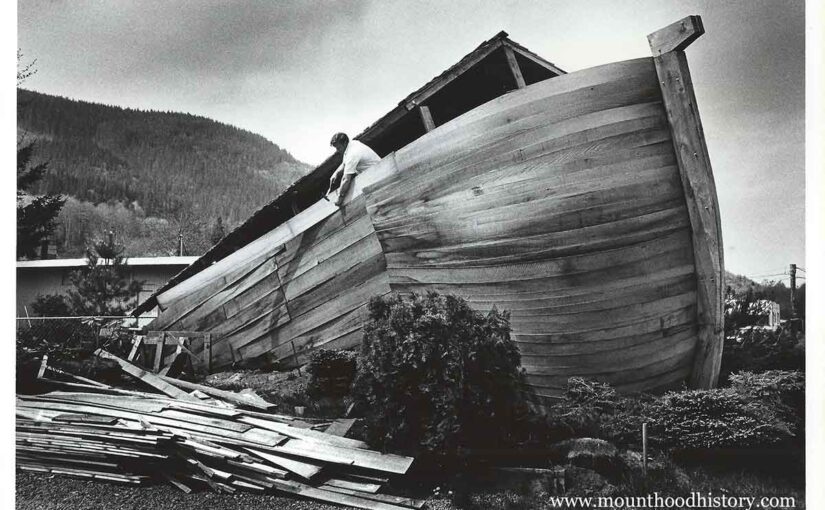
April 17, 1985. The Oregon Ark Motel.
“Richard Lightbody, owner of Oregon Ark Motel, puts final touches on “ark” he is building out of bender boards, even though area has had fewer than 40 days of rain a year. He said ark was not meant to save souls but to attract attention to his motel on U.S. 26, which he has owned since June.”
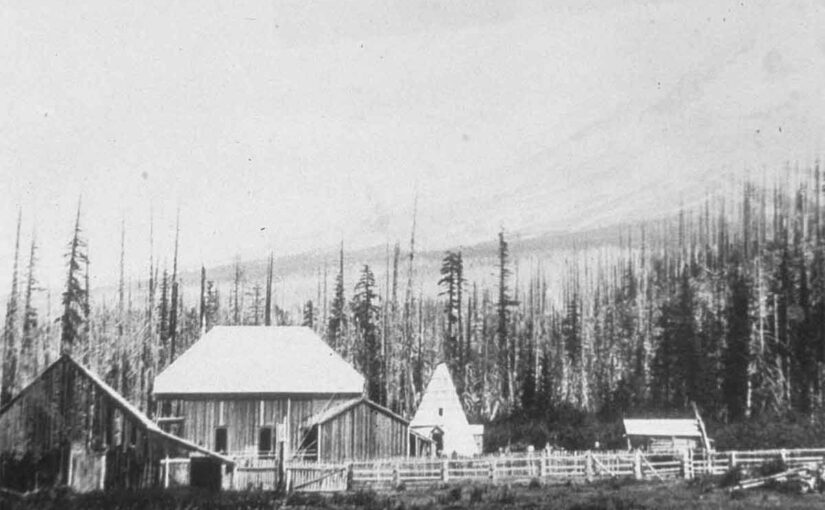
When people think of Mount Hood, crime usually isn’t the first thing that comes to mind. Especially not murder. Yet, one story from Mount Hood’s past should be told—the mountain’s first recorded murder. This is the story of the first Murder on Mount Hood.
For about 40 years, the Oregon Trail carried settlers west, and became the main route into the Willamette Valley. Samuel Barlow and Joel Palmer blazed the trail over the south shoulder of Mount Hood. Soon after Barlow made the trail a toll road. Tollgates were placed along the route to collect fees from travelers. One tollgate keeper, Perry Vickers, became an integral figure in the history of Mount Hood.
Perry Vickers was among the first residents on the south side of Mount Hood, an area that today includes the small ski town of Government Camp. He was well liked by everyone, especially those passing over the Barlow Road in their wagons.
He secured squatter’s rights at Summit Meadow, a natural clearing at the top of the pass, in 1865. Here, the road began its descent down the west slope of Mount Hood, leading settlers on the final stretch toward the Willamette Valley. Vickers built the first accommodations in the area, including a lodge, store, barns, and a corralled field for livestock.
During his time on Mount Hood, Portland grew rapidly with the influx of new settlers. Many of these settlers returned to the mountain, over the road that had once challenged their or their parent’s journey, seeking recreation and adventure.
Vickers became Mount Hood’s first climbing guide. Hiking and climbing the peak became increasingly popular at the end of the 19th and early 20th centuries. He enthusiastically promoted visitation and recreation. Vickers even created a tradition of lighting the mountain by carrying fuel for a large fire near what is now known as Illumination Rock. He is credited with being the first person to spend a night atop Mount Hood.
In August 1873, Vickers survived a night on the summit by building a crude rock shelter. Later, he recalled, “I dared not sleep, lest the cold take me. At dawn, I beheld a glory of light such as mortal eyes rarely see.”
Vickers was known as a dreamer and a poet. Newspapers later referred to him as “the mountain’s first true romantic.” The Oregon Historical Society preserves some of his verses about sunrises over the Cascade peaks and sunsets glowing across the summit.
However, his start in Oregon wasn’t on solid footing.
In 1865, Vickers arrived in Vancouver, Washington. While looking for work, he fell in with three other young strangers. Unfortunately, they were soon arrested at Fort Vancouver for horse theft, a serious crime at the time.
They were held for about two months awaiting trial. Each prisoner wore an “Oregon Boot,” a seven-pound iron clevis attached to the ankle to prevent escape. Public sympathy grew for Vickers, who consistently protested his innocence.

Worried that guilt by association would seal his fate, Vickers planned an escape. Their wooden cell allowed them to pry loose several 2″x4″ window bars, and the group fled into the night.
Once free, Vickers separated from his companions. Pursuers closed in as he reached the Columbia River. His ankle was chafed and bleeding from the iron shackle. In desperation, he plunged into the mile-wide, fast-moving river.
Miraculously, he swam across with the seven-pound clevis still attached to his ankle.
On the far bank, Vickers found a farm where he pried off the iron using a wagon wheel wrench and a bolt. The next morning, woodcutters gave him food and directed him to Powell Valley, where his brother lived. His brother provided clothes and supplies and urged him to head east along the Barlow Road to find work until the danger passed.
Traveling east, Vickers met Stephen Coalman, the overseer of the old Barlow Road. Coalman offered him work clearing storm damage from the road, and Vickers accepted. The two men formed a lifelong friendship.
Stephen and his son Elijah “Lige” Coalman would later become legendary for their adventures on Mount Hood. Over time, Coalman became convinced of Vickers’ innocence.
In June, Vickers set up camp at Summit Meadow and explored the area up to the timberline. He swore he would one day reach the mountain’s summit.
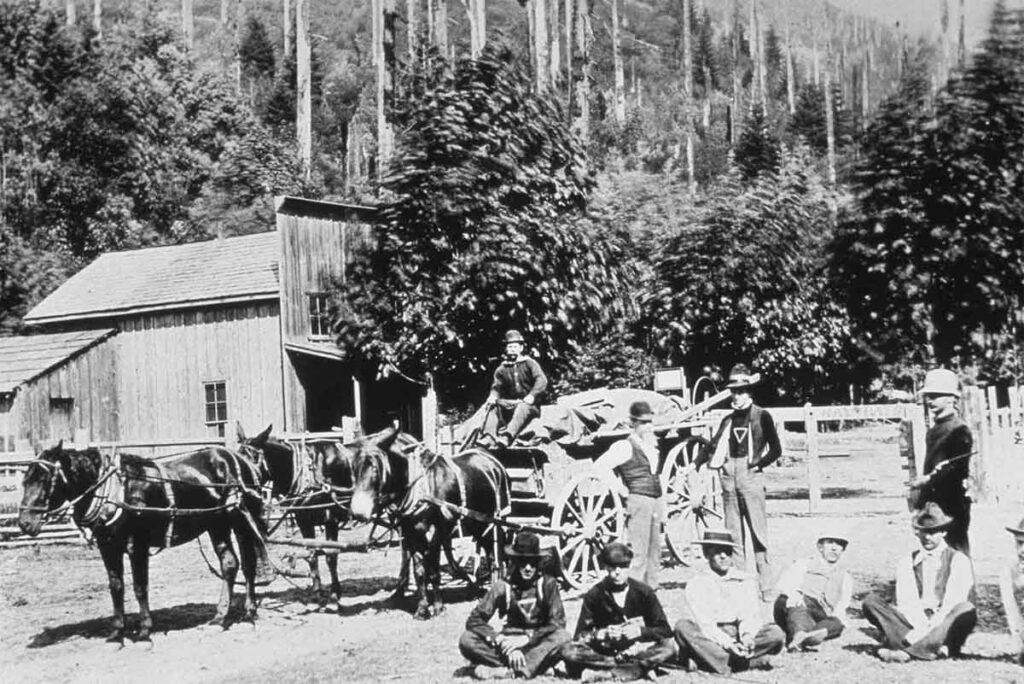
At first, Vickers worked as the eastern gatekeeper on the Barlow Road. In time, Coalman convinced him to return to the west side of Mount Hood, promising to help him with legal services if needed.
No charges were ever brought against him.
Vickers loved the Summit Meadow area. He filed a squatter’s claim and started building between his work on the road. In 1866, construction of the Summit House began. The building measured 20x20x32 feet, featuring a huge fireplace, upstairs sleeping quarters, and a large kitchen. Vickers built all the furniture by hand from local materials.
By the spring of 1868, as soon as the snow melted, the Summit House opened for travelers. Vickers provided food and shelter for people and livestock. He often refused payment from settlers who had little to give, earning a reputation for generosity.
In 1882, a tragedy struck Summit Meadow. A baby boy from a wagon party, the Barclay family, became ill and died at the meadow. Vickers granted permission for the boy to be buried there. The grave and headstone still remain today.
Later accounts said that Vickers personally tended the grave, keeping it marked and protected from passing livestock.
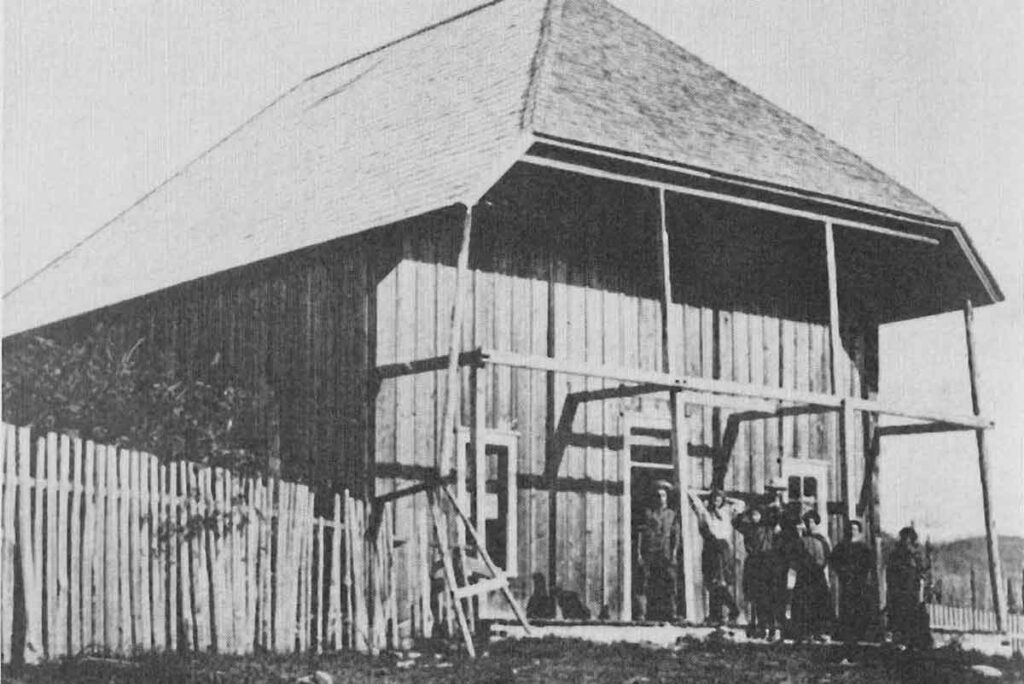
For years, Vickers remained at Summit Meadow, aiding travelers and leading hundreds to the summit of Mount Hood. Then, in August of 1883, violence shattered the peace and led to the first Murder on Mount Hood.
A man named Steele, a farmhand near the Columbia Slough, stole a shotgun and fled east. The Multnomah County Sheriff deputized two men, including the gun’s owner, Roarke, to pursue him.
The deputies tracked Steele to Eagle Creek and had their warrant reissued for Clackamas County. They learned that Steele had traded the shotgun for a powerful Sharps rifle.
Despite bad weather, they pressed on through Sandy, stopping only to buy a bottle of whiskey. Reaching the town of Salmon, near today’s Brightwood, they enlisted local trading post owner John McIntyre. One deputy, having fallen ill, returned home. McIntyre was deputized, and the search continued.
At Summit Meadow, Vickers told the men that Steele had stayed the previous night. Vickers warned them that Steele was a dangerous character and advised waiting until morning to pursue him, suggesting they rest and sober up.
Roarke insisted they continue into the night. Vickers, now deputized, reluctantly agreed to lead them.
They reached the White River Trading Post operated by Cornelius Gray. Beyond the buildings, they spotted a campfire.
Concerned about his companions’ condition, Vickers volunteered to approach Steele’s camp alone. As he rode off, he reportedly quipped, “If you hear me shout, don’t mistake it for the wind.”
Vickers rode toward the fire, confirming it was indeed Steele. As he dismounted his horse, Steele seized the Sharps rifle and shot Vickers in the stomach.
Vickers fell but managed to draw his revolver and fire into the darkness. Believing he might have wounded Steele, he emptied his gun but could not stop the fugitive.
Cornelius Gray, hearing the shots, rushed to the scene. He and others found Vickers gravely wounded, struggling to reload his revolver with trembling hands.
Vickers accused the deputies, Roarke and McIntyre, of cowardice, saying they abandoned him when he needed them most. Witnesses later agreed, noting that their horses had not actually bolted, and their retreat seemed deliberate.
A messenger rode to fetch Stephen Coalman, but it was too late. Vickers, lying inside Gray’s cabin, knew his fate.
He mentioned laudanum stored back at his lodge. Gray had nothing in his cabin to relive Vickers’s pain. Vickers acknowledged that no one could help him now. His final request was to be buried next to the Baby Barclay that he helped bury in his beloved Summit Meadow. His final words were reported as, “Tell them I did my best, for the mountain and for the law.”
At 7am, August 19, 1883 Perry Vickers died from his wounds. According to his wishes his body was loaded into a wagon and carried back to Summit Meadow and buried next to the baby.
The Mount Hood community mourned him deeply. Samuel Welch and Stephen Mitchell crafted his coffin, and Oliver Yocum officiated his burial.
Vickers is laid to rest at Summit Meadow, beside the Barclay child he had once shown such compassion toward. Their headstones remain today.
Locals remembered Vickers as “the silent sentinel of Summit Meadow,” honoring his years of guidance, kindness, and service on the mountain.
Soon after Vickers death a “religious eccentric” named Horace Campbell, known as “King David” occupied the Summit House. He rebuilt the Summit House and, behind the structure, constructed a conical shaped wooden teepee with a central fireplace and a smoke hole at the top. It was used by the last wave of immigrants over the old road.
In time, and after many occupiers of the old Summit House, the structure was fell into disrepair and was disassembled and burned on campfires by travelers. First the log furniture and then the structures. Today there’s no evidence that it even existed.
Billy Welch, The son of local rancher Samuel Welch, related a sad story about how Greeley, a yellow Newfoundland and Eskimo dog mix owned by Vickers, refused to leave his master’s grave for days. Finally he and Drum, a spotted hound, also belonging to Vickers, were brought to Welches to live with Samuel Welch, who had been a close friend with Vickers for years. It was necessary to keep a close watch on Greeley for days, because he wanted to return up the Barlow Trail to Summit Meadow where is master was buried.

Stephen Coalman kept Vickers’ blood-stained coveralls for years, hoping they might someday serve as evidence.
Later, a horse thief hanged in eastern Oregon claimed to have killed a man in the Cascade Mountains. It was widely assumed this was Steele.
Coalman, realizing the case had ended, eventually burned Vickers’ coveralls. Thus ended the story of Mount Hood’s first murder—and the enduring legend of Perry Vickers.

Protest at Timberline Lodge – Unfair to skiers.
Timberline Lodge ‘s first Winter was a rocky one business wise.
“From W. P. Gray
The News-Telegram
Portland, Oregon
12-23-1937
Two months after its dedication by President Roosevelt, Timberline Lodge on Mt. Hood, Oregon, $650,000 structure built with WPA money, was picketed by skiers who demanded immediate opening of the lodge’s sanitary facilities to skiers. No operator has been found for the massive Alpine hostelry, and “keep out” signs bar all doors. A corporation of Portland business men is reportedly forming to open the lodge. The picketing skier above is Ken Soult.”
#oregon #oregonhistory #timberlinelodge #mthoodhistory #mounthoodhistory

Timberline Summer circa 1940
Joie Smith was a legend on Mount Hood for 60 years. Her story will be told for years into the future.
Joie was everything from an Olympic skier to a pilot to a tow company owner and operator.
Smith, Joie Reid 85 June 17, 1928 – Mar. 29, 2014
A longtime Mt. Hood resident, Joie Reid Smith, passed away March 29, 2014, at her home in Rhododendron. She was born in Portland to June (Reid) and Oscar Clossett. Her mother married Blasdel Smith after Oscar’s passing. In 1953, she moved to Rhododendron where she operated a ski shop and later a towing business. Joie is survived by her half sister, Gayle Smith Kosel; numerous nieces; and a nephew. Her half brother, Sherrill Smith, predeceased her. A celebration of life will be held from 2 to 4 p.m. Sunday, April 27, 2014, at Mt. Hood Lions Club in Welches. Remembrances may be made to Camp Namanu through Camp Fire Columbia.
Published in The Oregonian from Apr. 11 to Apr. 13, 2014
This video brought tears to my eyes. I’ll miss my dear friend Joie Smith for the rest of my life. I have so many precious memories of our times together.
Thank you to everyone responsible for putting this video together. Thank you to my friend Bill White for his part and for the DVD copy.
James Harlow’s Mount Hood Climb 1931
James Harlow’s journal entry and photos.
Saturday and Sunday, September 19-20, 1931
James Harlow, Curtis Ijames, Cecil Morris, Everett Darr, Dr. Bowles and Ole Lien.
Ole came for awhile at noon, and we made definite plans for the climb up Mt. Hood over this weekend. Then I packed up and went over to Ole’s where we were to meet the fellows from Camas with whom we were going up. They were due at 7:30 but didn’t show up by 9:00 so we made arrangements to go up with Everett Darr and two of his friends. They came by after us by 10:30 and we started by 11:00 PM. Ole and I rode in the rumble seat. Everett’s two friends were Cecil Morris and a fellow named Bowles, a doctor. The car, a Chevrolet Coupe, belonged to Cecil Morris. We were at Government Camp by 12:45 AM Sunday. We didn’t stop at the hotel as Rafferty’s had gone to bed.
It was very foggy from Laurel Hill to Timberline but was mostly clear at Timberline with a 38-degree temperature. The mountain showed up white with a fresh coat of snow. We started on the climb about 3:00 AM with a fellow from Portland, Curtis Ijames by name, making a party of six.
We ran into snow a half mile above Timberline, and put on crampons half way to Triangle Moraine. The snow was well frozen and we hardly sunk in. There was a very heavy west wind and clouds were rapidly blowing across the mountain. The summit was obscured by the first streak of dawn. On Triangle Moraine there was probably an average of fourteen inches of snow piled into drifts, sometimes four or five feet deep. When the sun came up, we saw some beautiful cloud effects, the most wonderful colors I have ever seen.
When we got to Packs Rocks, we were in the fog and the wind tried its best to blow us off into White River Glacier. Upon reaching the first hot rocks, the wind was so hard we could barely move. At times, we just lay down in the snow and anchored ourselves with our ice axes. It wasn’t bad going up on the Crater Rocks drift until we got on the top of it. Then the wind was so bad it took us ten minutes to go 100 feet. The snow was soft, making the going hard. It was foggy most of the time and ice froze on our clothes. It took us quite a while to go the last 1000 feet because of soft snow.
It cleared up before we got to the top of the Summit Ridge. We looked down on a sea of clouds below 8,000 or 9,000 feet on the south and west and scattered clouds on the north and east. Fleecy strings of fog were blowing across the summit with tremendous velocity. And the gusty wind was so strong as to be dangerous. The rocks were ice-covered and the going was very treacherous. The last 200 feet over to the cabin was terrible.
We finally got to the cabin and went in, as the door was unlocked. It was very cold and the fire we lit in the kerosene stove did little to warm things up. We had arrived at the cabin about 11:30, and stayed about an hour. The shack swayed, creaked, and groaned crazily in that wind. The noise was terrific. Leaving about 12:30, we got down the chute okay but got lost in the fog below Triangle Moraine. The snow had softened and made the going very tiresome in the three and four foot drifts.
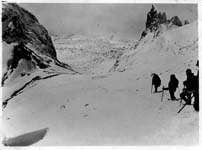
James Harlow’s Mount Hood Climb 1931 Journal entry and photos courtesy of Anne Trussell (Harlow), Sacramento, Ca.

Much has been written about how Welches, Oregon, got its name, but it isn’t the only town in the Mount Hood area that carries the legacy of its founding family. Just east of Welches and beyond the historic Zigzag Ranger Station, you’ll find Faubion Loop Road.
Although now a quiet residential area, it was once the home of the William J. Faubion family—early settlers who played a significant role in the development of the region. Their handcrafted log home and roadhouse, La Casa Monte, became a well-known stop for travelers along the old Barlow Road, which later became the Mount Hood Loop Highway.
In 1907, William and Anna Faubion moved their family to 80 acres just past Zigzag. The following year, in 1908, they built their home and named it La Casa Monte, meaning “The Mountain House.”
Like many settlers in the region, William Faubion made a living through timber work and hunting. He harvested the massive old-growth cedar trees on his land, cutting shake bolts to sell. To this day, remnants of this early logging can still be seen—several large stumps with springboard notches remain visible along Highway 26 near Faubion Loop Road.
Eventually, the family’s home evolved into something more—a place of hospitality and rest for weary travelers.
As traffic increased along the Mount Hood road, the Faubions converted their home into a roadhouse, similar to today’s bed and breakfasts. They called it La Casa Monte (“The Mountain House”), a fitting name for its rugged yet inviting presence in the wilderness.
The home itself was an architectural marvel for the time:
Inside, the rustic charm continued. Handmade furniture filled the rooms, and the walls were adorned with mounted animals, showcasing William’s skill as a hunter. The abundance of game in the area made hunting a necessity and a way of life for early settlers.
However, it was Anna Faubion’s cooking that truly put La Casa Monte on the map. Known especially for her huckleberry pies, she made the inn a favorite stop for early tourists heading to Mount Hood.
As the community around the roadhouse grew, it became more than just an inn—it became a settlement of its own. The addition of a store and post office turned Faubion into an official location.
The store and post office were operated by Aneita (Faubion) and Thomas Brown, William and Anna’s daughter and son-in-law. It became a popular stop for early motorists and adventurers traveling up the Mount Hood road.
Much like the Rhododendron Inn, La Casa Monte served a critical role in accommodating early automobile tourists, who at the time took hours to reach Mount Hood due to the primitive roads and slow vehicles.
William and Anna Faubion had seven children—three boys and four girls. Their oldest daughter, Wilhelmina Jane (Jennie) Faubion, was born in Gladstone, Oregon, in 1890.
At twenty years old, Jennie married William “Billy” Welch, the son of Barlow Trail pioneers who had homesteaded the area that later became Welches, Oregon. She lived there until her passing in 1985 at the age of 95, connecting two of Mount Hood’s most historic families.
Most of the other Faubion children remained in the area, becoming well known as an important part of Mount Hood’s history.
With the construction of the modern Mount Hood Highway (Highway 26), Faubion—like many other historic settlements—began to fade.
Although the original Faubion structures are gone, the community they helped establish continued to grow.
Despite the passage of time, residents of the area still recognize their community’s history. To this day, many locals proudly say they live “At Faubion.”
The story of La Casa Monte and the Faubion settlement is one of pioneering spirit, hard work, and adaptation. Like the Rhododendron Inn, Welch’s Hotel, and other historic mountain retreats, it was a vital part of early tourism on Mount Hood.
While nothing remains of La Casa Monte, the legacy of the Faubion family lives on in the land they settled, the stories they left behind, and the name that remains on maps today.
Discover More Mount Hood History
If you love learning about Oregon’s past, check out more stories at MountHoodHistory.com.
Do you have memories or stories about the Faubion family or La Casa Monte? Share them in the comments below!
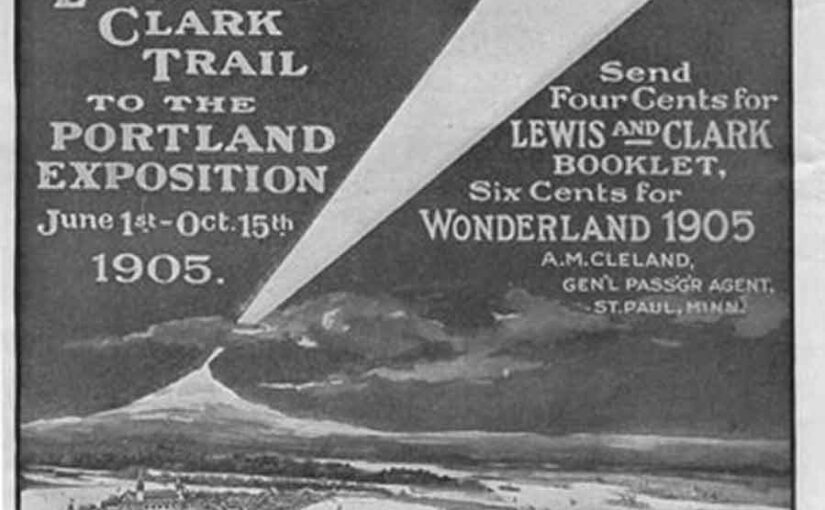
It was 1905, one hundred years after the Corp of Discovery was sent west from the United States into the wilderness to report the makeup of their newly acquired territory, and Portland Oregon was throwing a party to celebrate the occasion. In four months, 1.6 million people toured what was the equivalent to a World’s Fair with exhibits from nineteen states and twenty one different countries. Extravagant, if not substantially built buildings were constructed in the Spanish Renaissance style. It was quite an event with many different publicity stunts to draw attention to cooperators and to the event itself. One of which was an attempt at illuminating the summit of Mount Hood in a way that could be seen from Portland and the Lewis and Clark Expo.
Illuminating Mount Hood was nothing less than an obsession to folks in the late 19th century, as there were many attempts, and a couple successes.
Perry Vickers, Mount Hood’s first full time resident, started a tradition of building a bon fire on Mt. Hood in 1870 that lasted for many years. It was most likely not so much for the enjoyment of the people in Portland, but for the enjoyment of the locals who either participated in the building of the fires, or for those in Government Camp or campers at Summit Meadows, where Perry Vickers had facilities for travelers and campers. After a few bon fires, he was the first to initiate a blaze in an attempt be made visible from Portland. He used magnesium for the flame and was seen from Summit Meadow, but not in Portland. This was in 1873.
Several other unsuccessful attempts were made before two Portland men named George Breck and Charles H. Grove, on their second attempt on July 4th, 1887, were able to illuminate the mountain clearly, and bright enough to be seen in Portland. Their attempts were what gave Illumination Rock its name. Other notable names from the party were acclaimed conservationist William G. Steele, N.W. Durham. Govt. Camp’s first citizen and famous mountain guide Olliver C. Yokum, Dr. J.M. Keene and Dr. Charles F. Adams.
In 1901 plans were being made to illuminate the mountain as a part of the 1905 Lewis & Clark Centennial Exposition. Portland businessman and event co-organizer W.M. Killingsworth wanted an electrical light display featuring a huge statue of Lewis on one side of the mountain, and another of Clark on the opposite side. The logistics of such an event were wholly impractical for obvious reasons. Disregarding the construction and placing of the statues that would indeed need to be massive to be seen from such a distance, taking electricity to the mountain was also impractical, even if generated from the closest stream that could be used to power a generator, it was a fanciful but impossible feat.
On July 4th. 1905 “Plan B” for the illumination of Mount Hood for the exposition was put into place. A party consisting of George Weister, E.H. Moorhouse, Horace Mecklem, Mark Weygant and guide Peter Feldhausen proceeded up Cooper Spur for the summit, arriving at around 6pm. Upon reaching the summit, they held on in the frigid cold until the planned time of 9pm when they ignited the red powder that was to provide the flame. When the flame was ignited a wind blew through, taking some the fire down the mountain, thus subduing the flame making in near impossible to see in Portland, but it was reported at being visible in the Hood River Valley to the north. The party left the mountain top right away.
Many more illuminations were done in the subsequent years, with the most spectacular fire being the one that was done for the Mazama Climbing Club’s 75th anniversary in 1969.
The previous story doesn’t touch on the heliography that was done from the summit of Mount Hood, and will most likely be a subject of another story in the future.
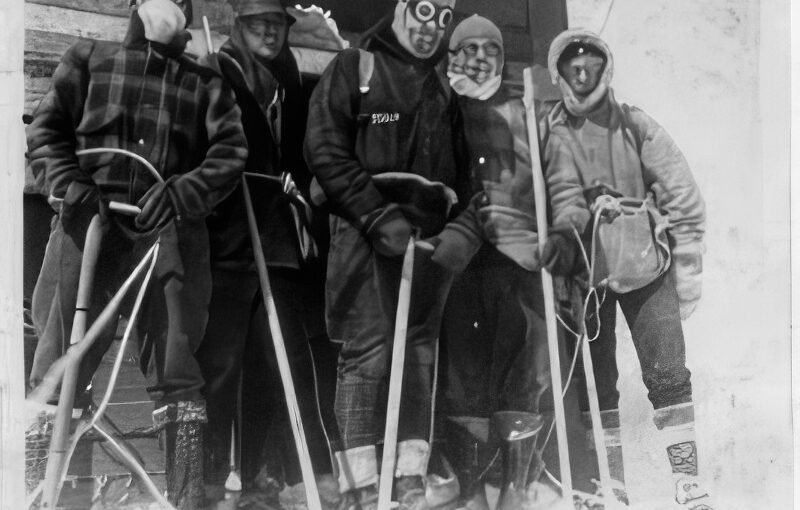
Climbing Mt. Hood “Back in the day” – Today I thought that I would post a great story about a typical climb from the 1930’s. I’ve been lucky to have been able to meet many historic figures, or their relatives since I started to pursue my interest in learning the history of Mt. Hood.
This story was forwarded to me through a conversation that I had with Anne Trussell (Harlow) from Sacramento, Ca. Anne is James Harlow’s daughter.
I hope that you enjoy this story.
Gary =0)
James Harlow’s journal entry and photos.
Saturday and Sunday, September 19-20, 1931
James Harlow, Curtis Ijames, Cecil Morris, Everett Darr, Dr. Bowles and Ole Lien
Ole came for awhile at noon, and we made definite plans for the climb up Mt. Hood over this weekend. Then I packed up and went over to Ole’s where we were to meet the fellows from Camas with whom we were going up. They were due at 7:30 but didn’t show up by 9:00 so we made arrangements to go up with Everett Darr and two of his friends. They came by after us by 10:30 and we started by 11:00 PM. Ole and I rode in the rumble seat. Everett’s two friends were Cecil Morris and a fellow named Bowles, a doctor. The car, a Chevrolet Coupe, belonged to Cecil Morris. We were at Government Camp by 12:45 AM Sunday. We didn’t stop at the hotel as Raffertys had gone to bed.
It was very foggy from Laurel Hill to Timberline but was mostly clear at Timberline with a 38-degree temperature. The mountain showed up white with a fresh coat of snow. We started on the climb about 3:00 AM with a fellow from Portland, Curtis Ijames by name, making a party of six.

We ran into snow a half mile above Timberline, and put on crampons half way to Triangle Moraine. The snow was well frozen and we hardly sunk in. There was a very heavy west wind and clouds were rapidly blowing across the mountian. The summit was obscured by the first streak of dawn. On Triangle Moraine there was probably an average of fourteen inches of snow piled into drifts, sometimes four or five feet deep. When the sun came up, we saw some beautiful cloud effects, the most wonderful colors I have ever seen.
When we got to Packs Rocks, we were in the fog and the wind tried its best to blow us off into White River Glacier. Upon reaching the first hot rocks, the wind was so hard we could barely move. At times, we just lay down in the snow and anchored ourselves with our ice axes. It wasn’t bad going up on the Crater Rocks drift until we got on the top of it. Then the wind was so bad it took us ten minutes to go 100 feet. The snow was soft, making the going hard. It was foggy most of the time and ice froze on our clothes. It took us quite a while to go the last 1000 feet because of soft snow.
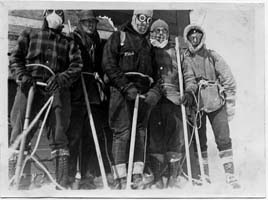
It cleared up before we got to the top of the Summit Ridge. We looked down on a sea of clouds below 8,000 or 9,000 feet on the south and west and scattered clouds on the north and east. Fleecy strings of fog were blowing across the summit with tremendous velocity. And the gusty wind was so strong as to be dangerous. The rocks were ice-covered and the going was very treacherous. The last 200 feet over to the cabin was terrible.
We finally got to the cabin and went in, as the door was unlocked. It was very cold and the fire we lit in the kerosene stove did little to warm things up. We had arrived at the cabin about 11:30, and stayed about an hour. The shack swayed, creaked, and groaned crazily in that wind. The noise was terrific. Leaving about 12:30, we got down the chute okay but got lost in the fog below Triangle Moraine. The snow had softened and made the going very tiresome in the three and four foot drifts.
We finally got on the right path and got down to Timberline by 4:00 PM. Everett, trying to crank Cecil’s car, which started hard, punctured the radiator. We got it started down the road and he could coast nearly all the way to Rhododendron. Ole and I rode into Portland with Curtis Ijames in his Model T Ford delivery. We stopped at Government Camp and got a bite to eat at Rafferty’s so home by 7:30 PM, thus ending a great trip.